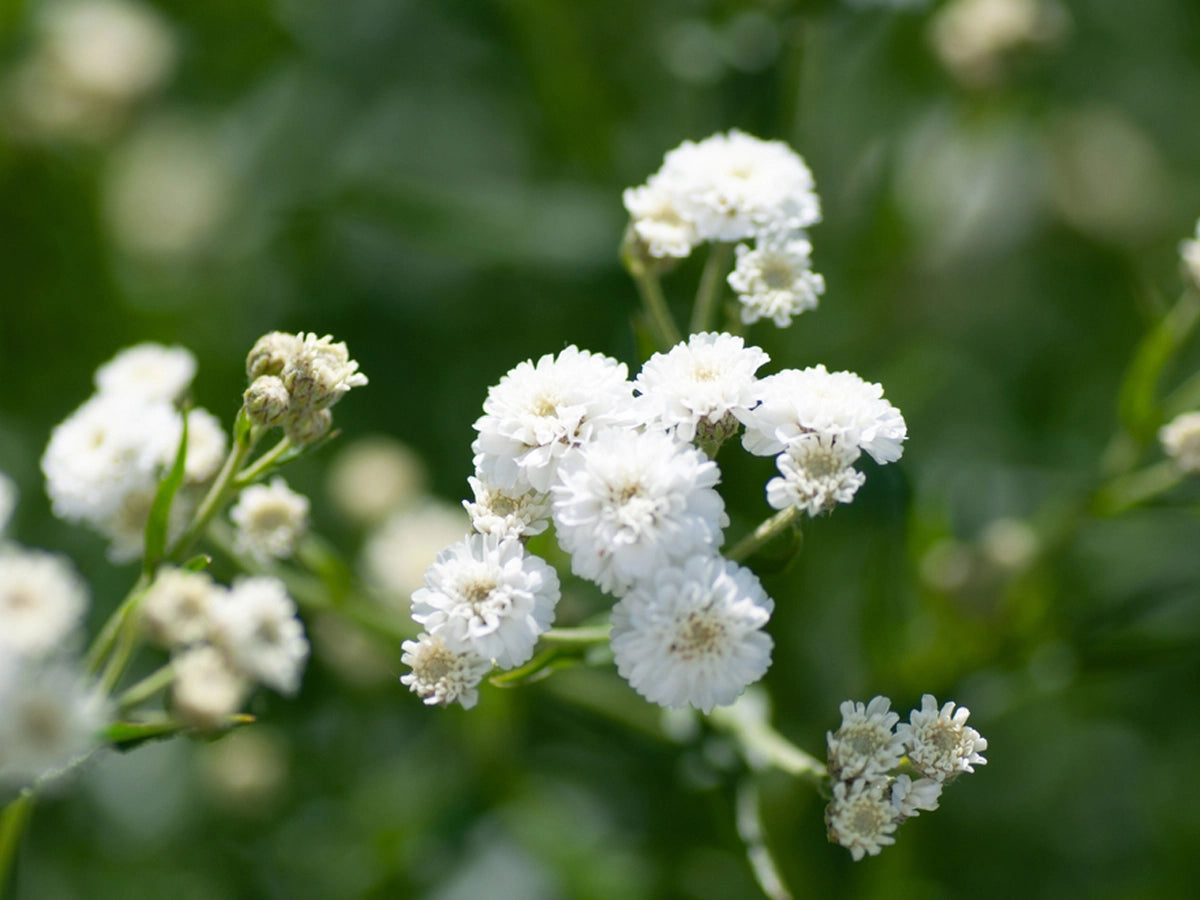How to Grow
How to grow Gypsophila: Facts, Benefits, Uses & Care Tips
I am Gypsophila, the queen of the sky,
A delicate flower, as light as a sigh.
My petals as soft as a baby's embrace,
A sight to behold, my beauty to grace.
I may be small, but I am not meek,
My presence in gardens will make your heart leap.
I come in shades, white and pink,
A sea of blooms that will make you think.
I'm not just a flower for the eye to see,
I'm a florist's delight for texture and glee.
So come, take a walk in my garden of dreams,
And let my beauty make your heart beam.
Are you tired of the same old flowers in your garden? Want to give your landscaping a whimsical and elegant touch? Look no further than Gypsophila, also known as baby's breath! Gypsophila may be small, but it is a total showstopper in the garden. This delicate and airy plant will fill your garden with a sea of fluffy white or pink blooms, adding a fairy-tale touch to any outdoor space. But Gypsophila isn't just a pretty face - it also has various benefits and uses in the world of floristry. In this blog post, we'll explore the joys of growing Gypsophila flowers, including facts, benefits, and tips on how to start and take care of them. So grab a pair of gardening gloves, and let's get started!
In this blog, we will cover the following topics:
- Facts About Gypsophila
- Different varieties of Gypsophila
- Benefits of Growing Gypsophila
- How to Grow Gypsophila Flowers at Home
- How to take care of Gypsophila Flowers?"
- Other ways to use Gypsophila
Facts About Gypsophila:
- Gypsophila is a genus of flowering plants that belongs to the carnation family.
- The genus includes around 150 species of annual, biennial, and perennial plants, all native to Europe, Asia, and North Africa.
- They are commonly known as baby's breath due to their delicate and airy appearance.
- Gypsophila plants typically have small, star-shaped flowers arranged in clusters.
- Gypsophila plants can grow to be anywhere from 1.5 to 2 ft.
- The flower blooms from summer to fall. For 30–40 days, it blooms abundantly.
- Seeds or cuttings can propagate Gypsophila.
Different varieties of Gypsophila
Gypsophila comes in various colours, each with its special meaning. Let's check it out:
White Gypsophila
White is the classic colour, and it symbolises purity and innocence. It's a popular choice for weddings and other romantic occasions because it adds a touch of sweetness and integrity to the bouquet or centrepiece.
Pink Gypsophila
This colour is all about love and grace. It's a popular choice for romantic gestures and expressing gratitude. Give your significant other a bouquet of pink Gypsophila, and they'll know how much you appreciate them.
Blue Gypsophila
This colour is all about peace and tranquillity. It's an excellent choice for promoting calm and relaxation. Use it in a floral arrangement in your home or office to create a serene atmosphere.
Purple Gypsophila
This colour is all about elegance and luxury. It's perfect for formal events and high-end decorations. Add it to your centrepiece for a fancy dinner party, or use it in a bouquet for a black-tie event.
Red Gypsophila
This colour is all about passion and energy. It's an excellent choice for adding a pop of colour to any arrangement. Use it to liven up a bouquet or centrepiece for a birthday or anniversary.
Yellow Gypsophila
This colour is all about friendship and joy. It's perfect for brightening up any room and spreading cheer. Use it to add a touch of sunshine to a floral arrangement or give it as a gift to a dear friend.
So, there you have it! Next time you're picking out a bouquet or arranging flowers, keep in mind the different meanings behind the colours of Gypsophila. It'll add a whole new level of meaning to your floral creations.
Remember, feel free to mix and match the colours for a unique and personalised touch. Happy flower arranging!
Benefits of Growing Gypsophila
The Gift of Whimsy
Gypsophila adds a touch of fairy tale magic to any garden with its delicate and airy blooms. Its small size and soft appearance make it an excellent option for filling in gaps in borders or adding texture to floral arrangements.
Versatility is the Spice of Life
Gypsophila is a versatile plant that can be used in many different ways in the garden, including as a border or bedding plant, in rock gardens, or as a cut flower. Plus, its small size makes it perfect for container gardens or small spaces.
Pollinator Party
Gypsophila attracts pollinators such as bees and butterflies to the garden. This characteristic makes it an excellent option for those who want to support local pollinator populations.
Drought-Tolerant Delight
Gypsophila is a drought-tolerant plant and can grow in poor soil conditions. So, you don't have to be a master gardener to keep it thriving in your garden.
Propagation Made Easy
Gypsophila can be propagated by seed or cuttings, making it easy to create more plants for your garden or to share with friends and family.
A Florist's Best Friend
Gypsophila is a popular choice for florists, as it adds volume and texture to floral arrangements. It acts as a filler in bouquets and centrepieces.
Dried Delights
Gypsophila is perfect for drying and creating dried flower arrangements. The delicate flowers will keep their shape and colour, making them ideal for long-lasting decorations.
Medicinal Marvel
Gypsophila species assists in treating conditions like asthma, bronchitis, diarrhoea, and other ailments.
Symbol of Love
Gypsophila symbolises everlasting love and purity.
How to Grow Gypsophila Flowers at Home
Growing Gypsophila from seed
- Start seeds indoors six to eight weeks before your location's latest day of frost.
- Compost seeds should be placed in seed trays or pots and then well-watered.
- Place the seeds on the compost's surface, then sprinkle a thin layer of vermiculite.
- Put the plant in a propagator, wrap it in a plastic bag, and store it in a warm location.
- Keep the compost moist but not waterlogged.
- Germination usually takes 7-14 days.
- Transplant seedlings into 9 to 15-inch pots once they are big enough to handle.
- Gradually acclimatise them to outdoor conditions for 10-15 days before planting.
Growing Gypsophila from cuttings
- Take cuttings of side shoots of 3-5 inches.
- After removing the lower leaves, put the cuttings in the powdered rooting hormone.
- Insert the cuttings into a propagator, cover them with a plastic bag, and put them in a bright, warm place.
- Keep the compost moist but not waterlogged.
- The cuttings should root within 4-6 weeks.
- When the cuttings have rooted, transplant them into 9- 15 inch pots and grow them in light shade for the first summer.
How to take care of Gypsophila Flowers?
Soil
Gypsophila prefers well-drained, sandy soil with an alkaline pH between 7 and 7.5.
It can, however, tolerate a slightly acidic pH of 6.5.
Use garden lime to neutralise acidic soil.
If the soil is heavy or clay-like, mix in sand or coarse grit to improve drainage.
Sunlight
Gypsophila plants require a minimum of 6 hours of direct sunlight daily for optimal growth and flowering.
While they can tolerate some shade, particularly in the afternoon, excessive shade may lead to fewer blooms.
Location
It would be best to plant Gypsophila in a spot that receives full sunlight for optimal growth and blooming.
To improve soil quality, adding compost or peat humus to the area is beneficial before planting.
It can also be grown in pots or containers as long as they have good drainage.
Fertiliser
Fertilise Gypsophila every 4-6 weeks during the growing season with a balanced fertiliser.
Avoid over-fertilising, as too much nitrogen, can lead to leggy growth and fewer flowers.
Water
Gypsophila is drought-tolerant and does not need a lot of water.
Water the plant when the soil is dry, but do not overwater.
Temperature
Gypsophila can survive in zone 4-9 but can be affected by temperatures below 40°F.
For a controlled environment, the ideal temperature for cultivating the plant as a cut crop is 59°F at night and 77°F during the day.
Pruning
Remove dead flower stems after they fade to promote a second blooming round.
After the second blooming period, significantly prune the plant by cutting all stems down to about 1 inch above the ground.
Mulching
Gypsophila is not tolerant of extremely low temperatures or freezing.
Cover the plants with a layer of mulch made of dry leaves and twigs to protect them from freezing.
Different ways to use Gypsophila
Did you know there are many ways to enjoy this delicate beauty beyond just sticking it in a vase? Here are a few fun ideas to make the most of your Gypsophila:
Create a whimsical floral crown
Gather a few stems of Gypsophila and weave them into a simple floral crown. It is the perfect accessory for a garden party or a festival.
Decorate a cake
Gypsophila adds a touch of elegance to any cake, and it's perfect for a wedding or anniversary. Just stick a few stems into the icing, and voila!
Add some sparkle
Gypsophila looks beautiful, but you can also add some sparkle by attaching small fairy lights to the stems. It creates a magical and romantic atmosphere.
Create a Gypsophila wall
Take a large piece of foam board, attach some nails and start sticking the stems of Gypsophila in random order. Once you are satisfied with the look, you can hang it on your wall. It will be a beautiful statement piece.
Use it as a boutonnière
If you're looking for a unique boutonnière for a groom or groomsmen, a small sprig of Gypsophila is an excellent choice. It brings a subtle sense of refinement without being overpowering.
Use them as a photography prop
Gypsophila is perfect for photography. They add a touch of elegance and natural beauty to any photo.
Make your bouquet
Gather a few stems of Gypsophila and mix them with your favourite flowers to create a unique and beautiful bouquet. The small, fluffy blooms will act as a filler and add a whimsy to your arrangement.
Take Away
The tree of Gypsophila has finally grown tall and strong, spreading its delicate petals to the sky! It makes me so pleased to bring a little bit of grace and beauty to any situation. Thanks to its caretakers for nurturing it. It is here to brighten your day.
Now, let's spread some joy and beauty together!



